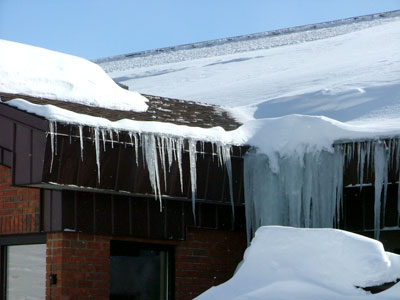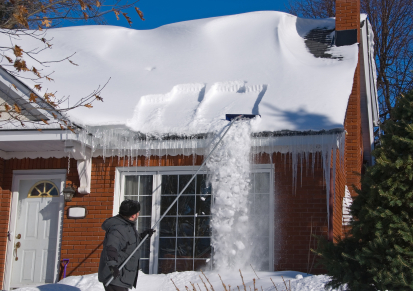By Heather Gwilliam
It’s that time of year where I get to sit back, peek out the window at my next door neighbor and enjoy my annual winter entertainment. It’s absolutely fascinating to watch him slowly and painstakingly remove the snow from his roof using a series of long handled rakes, brooms, and shovels.
I, on the other hand, eliminate ice and snow from my roof by flipping a switch and then settling back with a mug of hot chocolate to take pleasure in the show next door. Melting the snow on your roof with the flip of a switch, you say? How is that possible?
With a roof de-icing system from Heatizon Systems.
Cold temperatures and heavy snowfalls can quickly create dangerous and destructive conditions on the roofs of homes and buildings. Sharp icicles, thick layers of ice known as ice dams, and heavy snow slides cause millions of dollars in damage and injure hundreds of people every year.
Cosmetic Damage. The most obvious damage from snow storms is cosmetic damage, including damage to individual shingles, damage to gutters and fascia and other roofing elements. As the snow melts each day, some of the water re-freezes at night. As this cycle continues, ice can accumulate in valleys, gutters and at the eaves of the roof.
Thomas Remodeling says this freeze-thaw cycle is the cause of most of the cosmetic damage they see each year. Ice will expand in the gutters and cause seams to fail and the weight can bend and break the brackets holding the gutters to the home. Down spouts can split especially as water freezes in the down spout.
Structural Damage from Weight of the Snow. Another type of damage can occur from the sheer weight of the snow sitting on the roof and in the gutters. Not all snow is the same. The water content in heavy wet snow will be much greater than dry light snow. One cubic foot of heavy wet snow can weigh up to 20.81 pounds. That’s twelve inches of snow. Keep adding snow, and you can see how quickly the weight can add up. Excessive weight can lead to structural failure. It is no wonder that we see roof failures after major snow storms.
These types of structural failures are most often seen on commercial buildings with flat or low sloped roofing. Some of the worst collapses occurred where a winter storm was followed by a heavy rain some days later. The rain simply has no place to go.
Personal Injury. Every winter, hundreds of injuries result from people trying to deal with winter roof woes.
Although attempting to clear heavy ice and snow from their roofs is a common occurrence, experience shows that it can also be dangerous. The Journal of American Insurance says that they’ve seen people do “some bizarre and even crazy things…over zealous homeowners continue year after year to attack these rooftop glaciers with an arsenal of household weapons that would have left General George S. Patton’s celebrated Third Army running for cover. These include, but are not limited to, ice picks, hammers, chisels, pickaxes, blow dryers, space heaters, shovels and brooms, garden hoses connected to household water heaters, and even panty hose stuffed with rock salt.
These household warriors, while brave and well intentioned, often don’t do themselves or their homes any good. Ventures onto slippery roofs in cold weather can exact a heavy toll in the form of bruises, broken bones and other serious injuries. Moreover, a homeowner armed with an ice pick or pickaxe has been known to cause more damage than if the roof had been left alone in the first place.” “As you can imagine, falls from roofs can cause very serious injuries, some of which are compensated by millions of dollars,” says attorney Michael Bersani. “Take it from me; my law firm and I have successfully won millions for workers who have fallen from roofs.”
Another source of injuries can happen when icicles, ice chunks or large amounts of snow suddenly and unmercifully slide off roofs onto walkways and entrances. One notable example of this type of injury took place in Dallas in 2011 when six people were hurt by snow falling off of Cowboy Stadium. One person suffered head trauma and a concussion, and five others were hospitalized.
Interior Damage from Ice Dams. Although the most obvious damage occurs on the exterior, with ruined shingles, fallen gutters and even roof collapses, some of the worst damage, takes place on the interior when ice and water penetrate roofing materials and create leaks.
”Ice dams are caused by heat escaping into an attic warming the underside of a roof, which melts the snow,” explains Daniel Morrison, Executive editor of Fine Homebuilding & Green Building Advisor. “The water runs down the roof until it gets past where the exterior wall is, and then it freezes — because the roof deck is no longer warm. The ice builds up and forms a dam as more water runs down onto it.”
The water beneath seeps into the cracks and crevices of the roof filling them with water, which expands when it freezes again, spreading the materials the roof is made from and creating gaps in the seal of the roof that keeps the building dry.
When those gaps become large enough, the roof will begin to leak, causing large amounts of water damage within the buildings structural interior which will require extensive repairs. If the damage is not addressed immediately, it can spread, causing a lot of damage to the structural integrity of the building.
Roof deicing and snow elimination systems help prevent the problems of ice and snow buildup around eaves, drains, valleys or entire roofs. These systems not only stop the damage caused by winter stress on a roof, but also remove the hazardous conditions of falling snow or ice and eliminate potential liabilities.
An effective system can prevent ice dams by heating the critical areas of a roof. The system maintains a consistent water flow off the roof or safely diverts melted water into heated gutters that drain into designated locations. This is achieved by having a uniform heat source properly installed.
“It’s important to prevent the buildup of snow and ice around roof eaves, drains, and valleys,” states Steve Bench, Managing Member of Heatizon Systems, based in Murray UT. Heatizon manufactures low-voltage electric radiant roof snow melt and deicing, radiant snow melting, radiant in-floor space heating and radiant floor warming systems.
An investment in a radiant heating system produces the perfect long-term solution to dangerous and destructive ice and snow build up on roofs, diminishing liability issues and increasing peace of mind. The Heatizon roof deicing and snow elimination system is the only way to permanently protect a home or building from winter woes.



